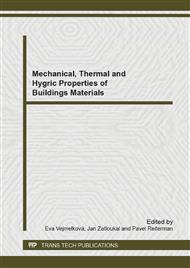p.100
p.104
p.108
p.114
p.119
p.125
p.130
p.136
p.141
Influence of Different Mechanical Properties to the Concrete Penetration Resistance
Abstract:
This paper describes influence of different mechanical properties to the concrete penetration resistance. The resistance is evaluated on the basis of the presented experimental program. In the experiment, non-deformable ogive-nose projectiles with diameter of 7.92 mm and mass of 8 g with impact velocity of about 700 m/s were hitting center of the specimens. Determination of the concrete penetration resistance was than based on projectile residual velocity obtained from high-speed camera record. The specimens were made from high strength concrete, steel fiber-reinforced concrete, ultra-high performance concrete and ultra-high performance fiber-reinforced concrete with different fiber content. The concrete penetration resistance was evaluated on total 32 specimens. Influence of mechanical properties, addition of coarse aggregate and steel fibers were discussed. Mechanical properties of the tested materials were investigated on total 125 specimens. Data from the measurements were used for creation of new RHT concrete models in Autodyn. In order to confirm experiment's setup and results, numerical analysis was performed in Autodyn. Results of the numerical simulations were compared to the experimental program.
Info:
Periodical:
Pages:
119-124
Citation:
Online since:
July 2014
Authors:
Keywords:
Price:
Сopyright:
© 2014 Trans Tech Publications Ltd. All Rights Reserved
Share:
Citation:


